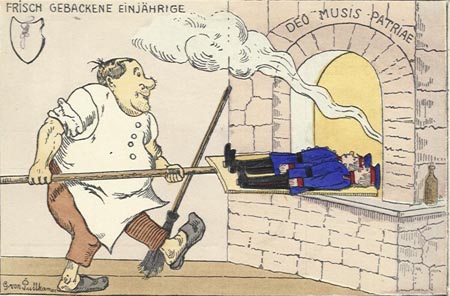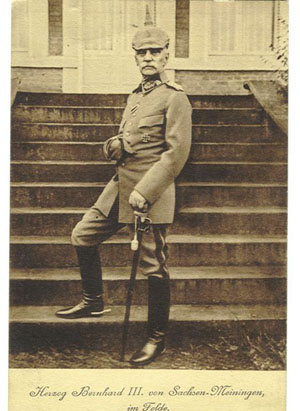-
Posts
352 -
Joined
-
Last visited
-
Days Won
1
Content Type
Profiles
Forums
Blogs
Gallery
Events
Store
Posts posted by joerookery
-
-
Ahhhhh but then we have this! A Hessian Shako!?!?!?!?! No shoulder straps.

 0
0 -
then sometime between 1907 and 1914
Goodness! Yes I should have given you more info! A retailer for sure. Nothng in it before WW1. Not a lot of medals or helmets. There probably is a big clue I've missed. A reprint of this andthe Neumann catalogs will be out in a few months.

 0
0 -
because depending on when in the war, Kr?ger could either have been middle aged or an underaged teenager and borne this "Private" designation.
Rick is spot on. It was more systematic in the Landwehr.
. Looking at the start of the war. The active-duty soldiers were those who had turned 20 in 1912 and 1913, which were born in 1892 and 1893. The reservists, where the next five classes: 1891, 1890, 1889, 1888, and 1887. There were more reservists than there were positions in the active regiment. Left over reservists formed or filled out other units.Active Units :
54% active duty soldiers
46% Reserve soldiers.
Reserve Units:
1% active duty soldiers
44% Reserve soldiers.
55% Landwehr soldiers from the 1st Ban
Landwehr Units:
62% Landwehr soldiers from the 1st Ban
38% Landwehr soldiers from the 2nd Ban
What I do not understand is what does 5th J?ger have to do with JR116? Yet there he is with a marked shako!
0 -
I'm trying to date a catalog without much success. However, this metal bar is offered for sale. Does someone know when this bar was issued? Clearly the catalog would be after that date. Thanks so much in advance.
 0
0 -
I have NO idea what is confusing you, or why. 2nd Lt 1891, 1st Lt 1900,
Hmmm something simple and VERY stupid. My old brain looked at 1900 and calculated 1890. I need more fingers and toes! Thanks!
0 -
Would a beamten actually be IN the military service (i.e. go through the training ).. wear the uniform...... get the paycheck that all other military personel get.. jsut not be in the command structure...
And would they were the uniform (other than distintive insignia) ?
Mark,
Hard one to compae to US positions! They were miltary and civilian uniform wearing, non-soldiers assigned to specific technical functions under the auspieces of the various war ministers. They had rank equivalencies. In the helmet world I have yet to find a comprehensive source in English but Stubbs makes a stab at it. They are not listed in the military pay charts. There were MANY types and the insignia changed over time.
examples include:
Pharmacists
Remount depots
Garisonverwaltung (real estate management.)
Military Court
Music inspectors.
People always think Zahlmeister becauser there were many and operated down to Bn level. (664 and 498 unterzahlmesters in the 166 Prussian regiments for example.)
My favorite story is that there were no miltary dentists before the war so they used civilians.
 0
0 -
Rick,
Thanks for your clear explantion of D3d. I still do not get the date? Why Oberleuntnant before his commission date? I'm missing something simple.....
Most One year men could finish the Abitur after the Oberprima year at age 19 and still do the year before university. He does seem odd.

 0
0 -
This has been wonderful! As usual I am lost by Horchler. Perhaps you all can help straighten me out. Just focusing on his commissioning side.
As Rick said we will never really know but in trying to piece this together?.
He got his One Year Certificate after his Untersekunda year, served his one year and RETURNED to the gymnasium to earn the Abitur (1884) so he could go to university (1884-1888).
Assuming he passed into the reserves as an aspirant NCO he would have to do two training sessions. One per year. After the first year?s eight week training session about how to be a platoon leader, he is promoted to Vizefeldwebel (1889???). After the second year (1890???) He would take the officer?s examination and would be promoted EXCEPT that he was artillery. Now it gets real murky? Because of his branch he would be an Ausseretatsm?ssigen or supernumerary until he had served one year, gone to a technical school and passed another test (Berufspr?fung).That would make it 1891. Commissioned a Lt.dR.
Ok all good until The Oberleutnant Patent in October 1900. I?m lost I also need help as I do not understand what D3d means??help me Mr. Wizard I?m falling!!
Where have I gone wrong Horchler is driving me nuts!!!

 0
0 -
Thanks so much! I know little of the mass commissioning. So much to learn.... Thanks again.
0 -
He is commissioned without seniority established, on 28 January 1916. That means he was very likely a 1914 war volunteer whose cadet training led to a mass of commissions at the end of January 1916.
Rick I'm having problems understanding ages and sources for all these 1914 Freiwillinge. Can you expand on your comment about cadet training please Thanks.
0 -
I'm having a mental block here. Who are these guys? All of my references say that there were 8 Prussian Abteilung (Guard, 1 to 7) and one Saxon unit, Nr 8. I have a photo montage (attached) that is dated 1909-1911 from Colmar that shows Machinengewehr 9.
Festungs-Maschinengewehr-Abteilung Nr.9-- If it were a Festungs Maschinengewehr-Abteilung I think it would have the word Festungs on the montage. The Festungs Maschinengewehr-Abteilung soldiers wore Infantry uniforms, not the Maschinengewehr-Abteilung.
Where am I messing up? Thanks in advance!


 0
0 -
Only 15 years before retirement? Seems a short time. Any thoughts on this?
Super cool goblet.
0 -
Thanks the web site is a lot of fun, because the keys my own head straight. I have no idea how Rick keeps all the stuff in his head. He knows what reference to go to. I have to write it down My brain is too full. It also is a monument to voice-activated software misspellings and all.
I recently received the catalog from Neumann. This is changed at least three thoughts on helmets. I read did the one year volunteer helmet article. More to come.
Where do I get the helmets? Private sales and auctions, primarily. I'm glad you have found the slippery slope. All of us junkies like to have more addicts.
0 -
That Prussian Pioneer helmet of yours, is it made with a black felt?
yes, I love it too. Fiber visors and a black felt body. More pictures:
0 -
Daniel,
I had thought that a one year volunteer would have been commisioned shortly after his one year of service was completed.Short answer no. Somehow, the "conventional wisdom" of one year volunteers had most of the information wrong. This has been continued through a lot of dealers. I really need to rewrite my article and intend to do so I soon as I finish the article on the Neumann catalog.
The existing article on one year volunteers is at http://www.coljs.com/articles/OneYearVolunteer.htm. There have also been some recent discussions at Pickelhaubes.com
0 -
Either the chinscales are correct and the plate is replaced or visa versa.
maybe both.
The guys at pickelhaube.com could probably give a lot more information. I often find that more eyes are better than two! Here are a few rambles from me.
convex chin scalesThey sure look that way, don't they? But I have found that finding the difference can be very difficult and the best way is to look at the rosettes.
Round Rosettes are for flat chin scales and oval ones are for convex chin scales. Diameter supposedly 27mm.
This one has a round rosette. So therefore should be a flat set of chin scales.
Q. What is the difference between Bavarian Officer Cavalry, Artillery and Infantry helmets?A. That is a very interesting question. Frankly, I always thought it is virtually impossible to sort them out. In order to provide unity for the manufacture of helmets after 1914 all Bavarian officers carried rounded chin scales. Prior to that time infantry and foot artillery units carried flat chin scales. "The Kriegsministerium-Verordnungsblatt Nr. 17 of the 20th of February 1914 introduced convex scales for officers of foot troops. The flat scales were permitted to be worn until the 1st of January 1916."
The oval rosette pictured above comes off a Bavarian helmet, but not one with M15 rosettes. Were there oval shaped M15 rosettes? I don't know.
The holes on the front of the helmet body are known as elongated holes. Frequently, this indicates an exchange of wappen. You have this wonderful early wappen from pre-1914. The chin scales are from 1915-1916. So maybe both. I know if I found this fine wappen. I would pop it on my helmet, if I could.
I have not seen that maker's Mark before. It looks super! The initials DRP stands for Deutsche Reich's Patent and you can see the patent number. Many helmet covers are marked DRP.
0 -
I think the scales are perfectly correct but long. They are the correct chin scales with the correct faux rosettes. It seems however, that they are perhaps one scale too long. So if it is a replacement. They may have come from a helmet that was larger to begin with. Nice helmet, really love the wappen!
0 -
I agree with Glenn. My added twist is that it was common to serve as a one year volunteer in Regiment number one and then move to Regiment number two for actual commissioning. He had to find a Regiment that would accept him as a candidate. A One year volunteer could choose any Regiment he wanted and I believe for the most part, there was no problem being accepted. They were free labor for the receiving unit. They did not count against the totals. It certainly sounds like a one year volunteer. Service in Regiment 82, commissioned into Regiment, 164.
Maybe when he moved into the reserves, he went off active duty into the reserves? He could have well served on active duty with a reserve commission.
Nice helmet! What color are the rings on the cockades? Are they gold or silver?
Mike,
Any chance of getting a better picture of that maker's Mark? What does it say?

 0
0 -
Very nice wappen! The chin scales look questionable, but as Dave said M15 type. This should be cool to take apart.
I have a Bavarian that has a far later wappen. Not nearly as cool as yours, but it does not have M 91 posts but does have a bayonet spike.

On the other hand, I have a Prussian pioneer that has the posts, but not the bayonet spike.
 0
0 -
Boy, did I screw that up! Okay, got it. The guy you do not recognize is Bernard III, the reigning F?rst. Hopefully I won't screw up this scan and cut off the caption.
I thought I understood the Th?ringian states but boy did I screw up that marriage thing.
The junior Albertine line took over Saxony and the senior Ernestine line got the Th?ringian area and sub-divided it many times among themselves.
 0
0 -
Thanks Rick!
FIRST photo (and GREAT to have a FACE, BTW) scanned above is correctYou mean the bottom left photo, don't you? That would make some sense, because his father Bernard III was old.

The guys in the upper left are the crown prince and his brother.

 0
0 -
Georg Of The One Name married in Freiburg im Breisgau 1919 Klara-Maria Gr?fin von Korff genannt Schmissing-Kerssenbrock (31.5.95-10.2.92)
Help me here. He married and had 4 kids between 1919 and 1925. I thought he lost his "position" due to an unequal marraige. Yet he became a priest in 1923. What did I screw up? Help me Mr. Wizard!
0 -
Were they brush painted or sprayed?
Both, as well as dipped. This one does not look so good to me sorry. But remember I might well be wrong.
0 -
Is there a sure way of telling if cockades are original apart from an obvious new paint job?
Good question and I say no. Many will say they can tell and certainly certain fakes stand out but the good ones and the real thing are tough. There was once a quiz on the old pickelhaubes forum that everyone flunked. Some folks did better than others but a sure way.....
I'd go for a tin pickelhaubeI have heard this term forever but I am coming to the conclusion it is just slang. I think what we have is very thin steel not tin. I know there were some test aluminum models made.
0




SWA Bar
in Germany: Imperial: The Orders, Decorations and Medals of The Imperial German States
Posted
Dan We don't care about the $$$. We are retired and do Ok. Breaking even would be nice but....
There are over 80 pages in this catalog and Neumann is bigger. Too much to post. If I think I found a clue I would gladly share. We do have a thid catalog brewing -- this one on flags from 1895.